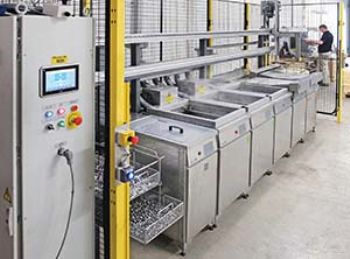
International legislation requires vehicle manufacturers to improve the efficiency of their engines in order to decrease fuel consumption and minimise the production of pollutants. One way to achieve this is to increase the pressure of the engine’s fuel injection system so that the liquid hydrocarbon is more finely atomised in the cylinders.
In the 1.5-litre petrol and diesel engine options that power the Ford Focus, for example, the fuel delivery pressure is 180 bar; in the next generation of vehicles, it will exceed 200 bar. Contrast this with the norm in the automotive industry of less than 10 bar a few decades ago.
The integrity of a fuel injection system is paramount, if it is to withstand ultra-high pressures. Unipart Powertrain Applications (called Unipart Eberspächer until March last year) ensures that every stainless-steel fuel rail it manufactures for the Ford Focus engine passes leak-testing at its Coventry factory.
This is carried out at 200 bar using air and then at 180 bar with helium, which is more searching due to the smaller molecule size. Periodic flush testing of rails and daily sectioning of a random brazed joint (followed by inspection through a microscope) are also performed.
One measure that is taken to ensure fault-free production is to wash the delivered components in an automated multi-stage ultrasonic cleaning line supplied by Hampshire-based Turbex Ltd (
www.turbex.co.uk). This promotes the subsequent production of consistently good brazed copper joints, without any porosity at the relevant pressures.
Simon Stowe, project planning engineer at Unipart, says: “Every element of the fuel rails, apart from the non-critical cast mounting legs, is processed through the Turbex line. In the past, we did not wash any fuel rail parts on-site but relied on our suppliers to guarantee their cleanliness. This worked satisfactorily, and we always met the quality standards laid down by our customers.
However, Unipart management took the decision to bring the control of cleaning in-house, as systems carrying pressurised fuel are safety-critical and specifications are becoming increasingly stringent.”
Another factor in the decision was the possibility of contaminating the brazing furnace if oil, lubricant or particulates are on the surface of components. This could compromise the integrity of the copper-brazed joints of the rail assembles and perhaps necessitate a costly stripping down of the furnace.
Any risk of scrappage or system down-time is unacceptable, especially with manufacturing volumes for the Ford 1.5-litre engines alone; these are currently around 4,500 per week, but predicted to rise to 8,500 per week by the end of this year.
When Unipart decided to install in-house cleaning, Turbex was the front-runner, as it was already an approved supplier. One of its AC series of front-loading spray-washing machines has been in use at the Coventry factory for more than a decade and is mainly used for cleaning kanban boxes. Initially, a small Turbex ultrasonic bath was rented to develop the process for cleaning the Ford fuel rail components.
The machine was later purchased to provide a permanent on-site facility for further development projects. The latest Turbex five-stage cleaning line was originally ordered as a manually operated facility, whereby baskets of components are moved along an overhead gantry and lowered by hand into each tank in succession.
However, Mr Stowe soon realised that an automated system would be preferable in view of the rising volumes of rails, so he asked Turbex to amend the order. Virtually all of the stainless-steel parts are processed, including the main rail, injector cup and tube, collars, inlets and end plugs. They are washed in kanban batches, and the carriers can accommodate a pair of baskets one above the other, so two different component types can be handled simultaneously.
Mr Stowe has programmed the line to complete the cleaning and drying cycle in 10min. The versatility of the line is such that up to five carriers — each holding one or two baskets of components — can be in the system at the same time for simultaneous processing, allowing the increasing volumes of fuel rail components to be accommodated.